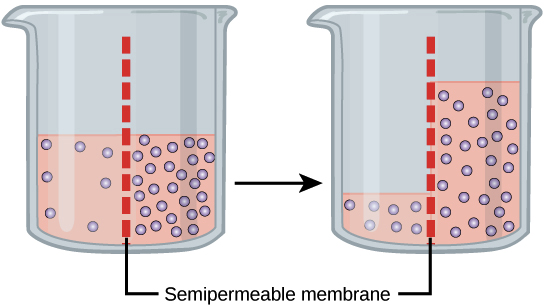The components of the plasma membrane
- Phospholipids: main fabric
- Cholesterol: tucked between the hydrophobic tails(core of the membrane)
- integral proteins: embedded the bilayer
- peripheral proteins: on the inner or outer surface, not embedded
- carbohydrates: (attached to proteins or lipids)on the extracellular side
Diffusion and osmosis
- osmosis: the net movement of water across a semipermeable membrane from lower concentration to higher concentration
- diffusion: molecules move from higher concentration to lower concentration as a result of probabilities
 |
| the solute molecules physically knocking the water molecules backwards, making them less likely to cross |
- tonicity: the ability of an extracellular solution to make water into or out of a cell by osmosis
- osmolarity: the total concentration of all solutes in the solution
- *only solutes that cannot cross the membrane
- hypotonic: extracelluar's osmolarity lower, inside the cell's higher(water out to in)
- hypertonic: extracelluar's osmolarity higher, inside the cell's lower(water in to out)
- isotonic: both's osmolarity same(no net movement of water)
Passive transport
- does not require to expend energy bc a substance diffusing down its concentration gradient
- concentration gradient: a region where the concentration of a substance changes(from higher to lower)
- non polar and small molecules readily diffuse across(carbon dioxide, oxygen..)
- polar and charged molecules have trouble crossing the core membrane
- facilitated diffusion: channels and carrier proteins
 |
| Aquaporins: channel for water molecules |
 |
| carrier proteins: change shape in response to binding of their target molecule |
Active transport
- the cell expends energy(ATP) to move substance against its concentration gradient
- membrane potential: an electrical potential difference(voltage) across cell membrane
- inside of the cell having extra negative charges(generally -40 to -80 millivolts)
- electrochemical gradient: the combination of concentration gradient and voltage(that affects an ion's movement)
- Active transport-primary active transport: sodium-potassium pump
sodium-potassium pump
- move Na+ out, K+ into cells
- uses ATP as an energy source
- generating the voltage across the membrane(electrogenic pumps)
The sodium-potassium pump cycle
- the pump is open to the inside of the cell, take up 3*Na+
- trigger the pump to hydrolyze ATP(phosphorylation, phosphate group attach to the pump)
- phosphorylation make the pump change shape, release 3*Na+
- the pump take up 2*K+, triggers removal of the phosphate group attached to the pump
- with the phosphate group gone, the pump change back to its original shape
- the pump release 2*k+, back to step 1
membrane potential generated by the pump
- too many K+ inside the cell(since the pump), the gradient is very steep
- K+ move out of the cell(via channels), negative charge inside is growing
- (negative charge inside big enough)K+ stops being imported, the voltage(difference, not flow)disappear
Secondary active transport
- the electrochemical gradients store energy
- secondary active transport uses the energy to move other substances against their own gradients
- when Na+ return to the interior of the cell via channel or carrier protein, glucose share the carrier(as a cotransporter)
- cotransporter: symporter(both move same direction) and antiporter(move in opposite direction)
Bulk transport
- Endocytosis: move particles into a cell by enclosing them in vesicle
- Phagocytosis: cell-eating, large particles are transported into the cell
- Pinocytosis: cell-drinking, cell takes in small amounts of extracellular fluid
- Receptor-mediated endocytosis: receptor proteins(on the cell surface) capture a specific target molecule *they cluster in coated pits(ex. Clathrin)
- Exocytosis: materials are transported from the inside to the outside of the cell(like from the Golgi apparatus)



No comments:
Post a Comment